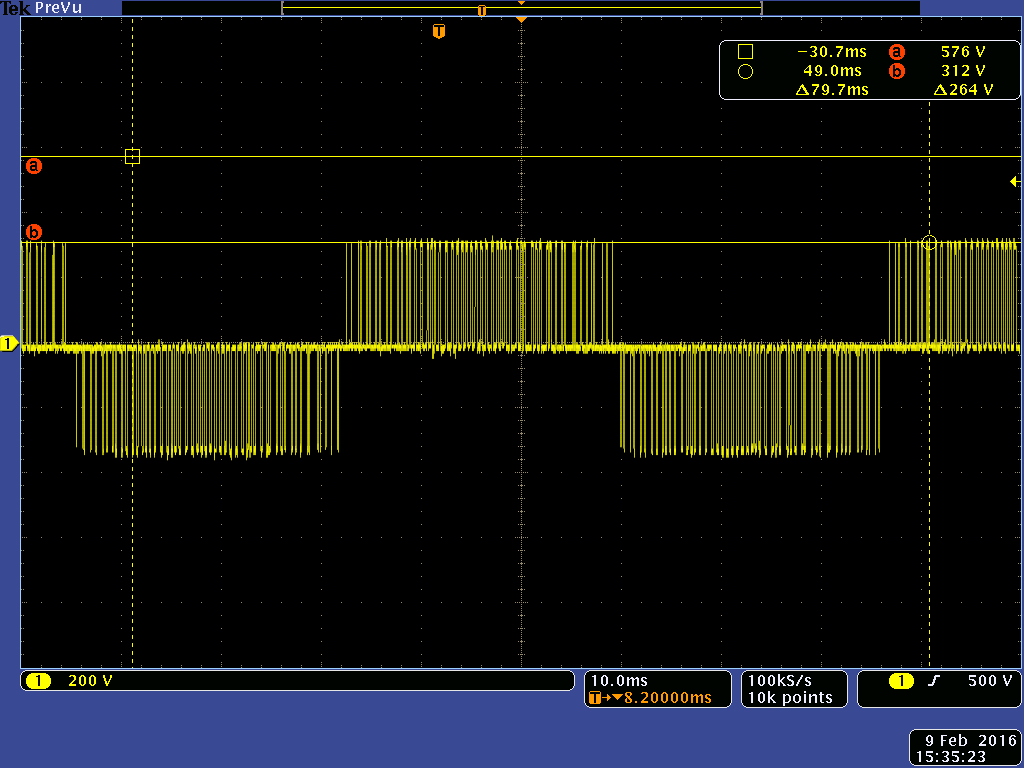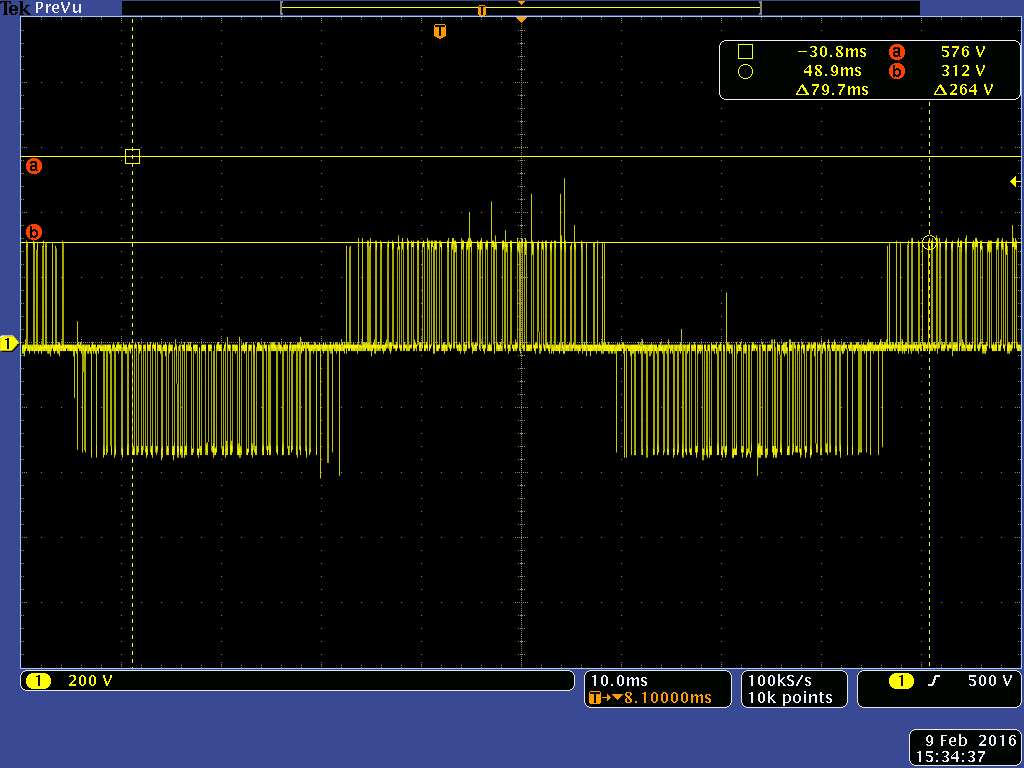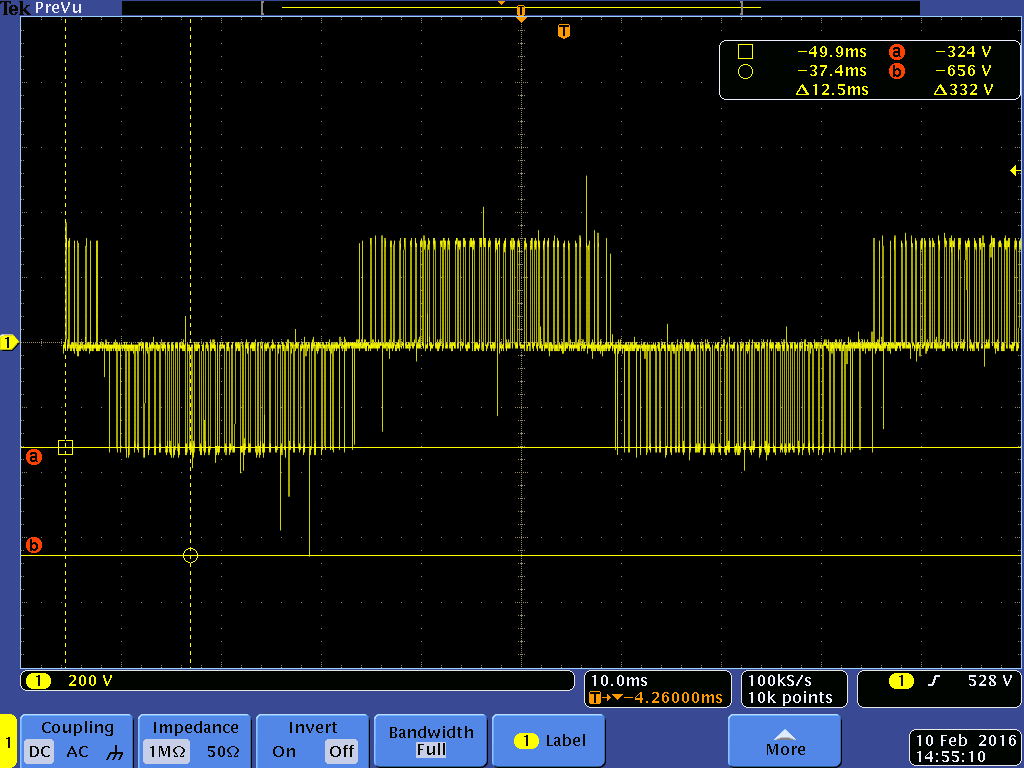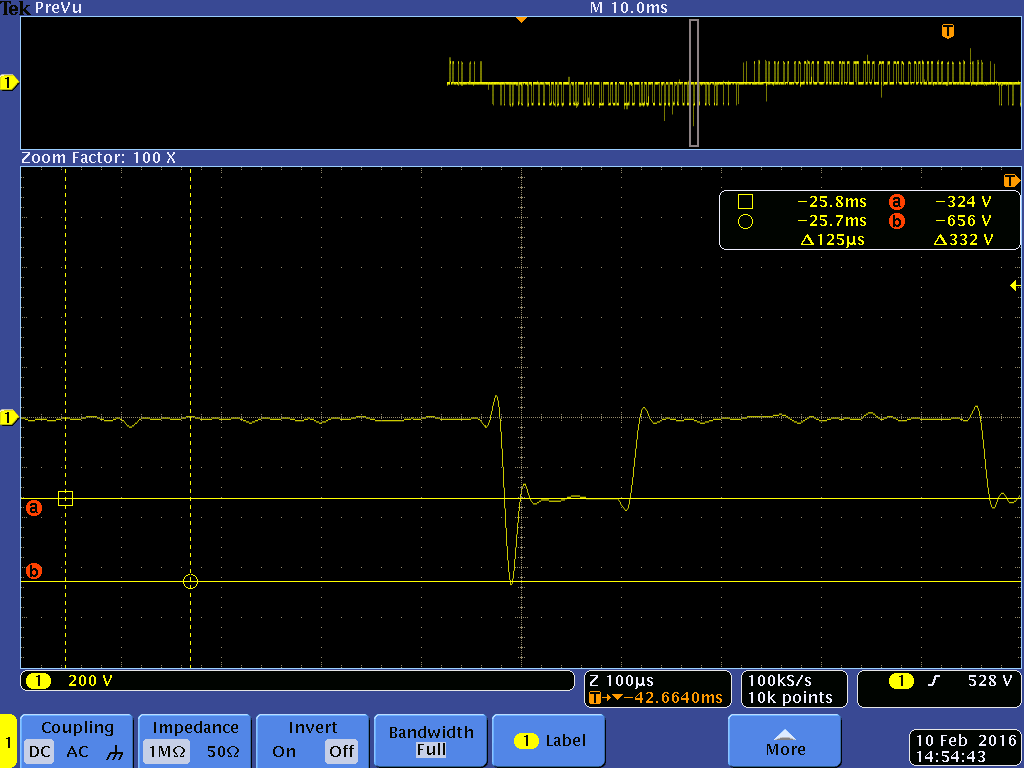
Intelligent probe up to 6 kV
Precision measurement of the surge test directly at the winding.

The VoltageAnalyzer serves to measure all kinds of high-voltages. The frequency range covers DC voltages up to very high pulse frequencies in the MHz-range.
This it is perfectly suited for high voltage, surge voltage and partial discharge measurements.
The active test probe measures voltages and voltage peaks exactly there, where they appear. This may be e.g. in the motor´s terminal board.
These voltage peaks may be caused by a frequency converter or by harmonics caused by the lead.
Voltage measurement at surge voltage and partial discharge
It happens, that the voltage internally measured by the surge voltage tester does not exactly correspond to the test object´s voltage.
This is due to unavoidable inductances in measuring leads and capacities between themn which influence the surge signal´s voltage course on the way to the test object. This especially occurs the higher the surge impulse rises.
However, to be able to precisely measure the partial discharge inception voltage (PDIV) connected to the motor´s terminal board, a direct measurement at the terminal board with the active test probe is required.
For exact this purpose, the VoltageAnalyzer has been developed! The voltage measurement is carried out between the same phases used for the surge voltage test.
To be able to fastly inspect a three-phase motor without reclamping, the VoltageAnalyzer is equipped with three measuring connections which are directly connected to the test object´s clamps U, V and W via preferably short measuring leads. The switchover between the three measuring connections is performed fully-automatic and simultaneously to the surge voltage test.
Communication with the tester
The VoltageAnalyzer is eqipped with a communication interface to the surge voltage tester. This interface serves to remote-control the tester and to transfer the measuring results to the surge voltage tester.
During the surge voltage test, the VoltageAnalyzer automatically switches to the currectly tested connections. The remote-control is done by the surge voltage tester.
Measured values
The following voltages are automatically measured by the active test probe:
Based on over 25 years experience, extensive know-how and constant improvements, with the combination MTC2/MTC3 plus VoltageAnalyzer you get the perfect „state-of-the art surge voltage tester“.
Voltage peaks due to frequency converter operation
At the frequency converter´s output the switching slopes are still very close to the rectangular, optimum shape. The following picture shows the voltage´s pulse course between two phases at the frequency converter´s clamps. The pulses, the pulse width modulation as well as the sine´s negative and positive half wave may easily be detected.

The voltage level results from the frequency converter´s AC-supply voltage. As each frequency converter firstly rectifies the input voltage, each converter is equipped with a DC capacitor bank, which is charged up to the input voltage x √2. For 230 VAC input value we get 320 VDC and for 400 VAC a value of approx. 560 VDC results. The picture shows a level of 315 VDC, which matches well with the 230 VAC supply.
The motor is connected with the frequency converter via leads. Leads are no ideal electric components as they consist of resistances, lead inductances and capacities. Due to this, the ideal rectangular pulse, which is still existent at the converter´s output, is strongly distorted on the way to the motor. High voltage peaks arise at the rectangle´s edges.

Lead 10 m length

Lead 20m length
In this example the voltage peaks are almost twice as high as the normal rectangular voltage at the inverters output. In practice, even higher voltage peaks may occur, which will inevitabely destroy the motor in case of an insulation which is not suitable for frequency drives.
The next picure shows a voltage peak in detail.

It is clearly visible, that the voltage peak is almost twice as high as the optimal rectangular pulse.
Voltage supply
Connections
Measuring channels
Test voltage
The VoltageAnalyzer is an intelligent test probe.
It generates no surge- or high voltage, but measures it.
⇒ Find more details under Downloads.
Spannungsspitzen durch Frequenzumrichterbetrieb
Die nahezu rechteckigen Schaltflanken des Frequenzumrichters sind direkt am Ausgang des Umrichters noch sehr nahe an der optimalen rechteckigen Form. Das nachfolgende Bild zeigt die Impulsfolge der Spannung zwischen zwei Phasen direkt an den Klemmen des Umrichters. Man erkennt sehr deutlich die Impulse, die Pulsweitenmodulation sowie die negative und positive Halbwelle des „Sinus“.

Die Spannungshöhe ergibt sich aus der AC-Versorgungsspannung des Frequenzumrichters. Da jeder Frequenzumrichter die Eingangsspannung zuerst gleichrichtet, gibt es in jedem Umrichter einen Gleichstromzwischenkreis, der sich auf die Eingangsspannung x √2 auflädt. Bei 230 V AC ergibt sich ein Wert von ca. 320 V DC und 400 V AC ein Wert von ca. 560 V DC. Das Bild zeigt einen Pegel von rund 315 V DC, was gut zu der 230 V AC Versorgung passt.
Der Motor ist über Leitungen mit dem Frequenzumrichter verbunden. Leitungen sind keine idealen elektrischen Bauteile, sondern bestehen aus Widerständen, Leitungsinduktivitäten und Kapazitäten. Dadurch wird der ideale Rechteckimpuls, der noch am Ausgang des Umrichters vorlag, auf dem Weg zum Motor stark verfälscht. Es entstehen sehr hohe Spannungsspitzen an den Flanken des Rechtecks. Diese werden umso ausgeprägter, je länger die Leitung zum Motor ist. Die nachfolgenden Bilder zeigen dies eindrucksvoll.

Leitung von 10 m Länge

Leitung von 20 m Länge.
Die Spannungspitzen sind in diesem Beispiel nahezu doppelt so hoch, wie die normale Rechteckspannung. In der Praxis können noch viel höher Spannungsspitzen entstehen, die den Motor bei einer nicht frequenzumrichtertauglichen Isolation unweigerlich zerstören.
Das nächste Bild zeigt eine Spannungsspitze im Detail.

Deutlich ist zu erkennen, dass die Spitze nahezu doppelt so hoch ist, wie der eigentliche Rechteckimpuls.
Für weitergehende Informationen steht Ihnen unser technischer Vertrieb auch gerne telefonisch zur Verfügung.
